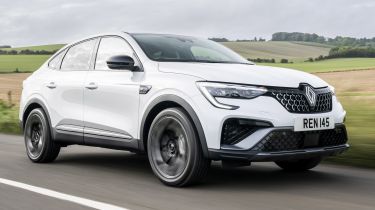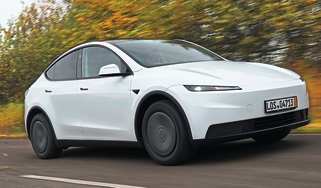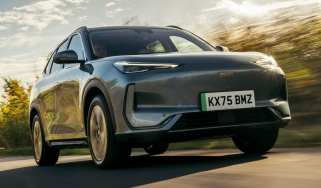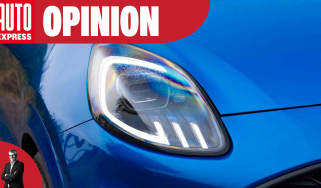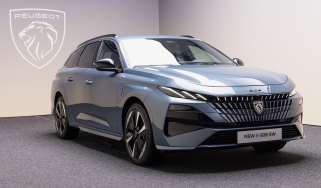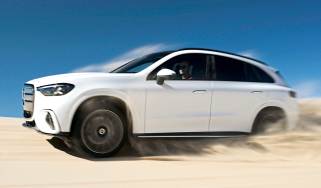Renault Arkana (2021-2024) review
The Renault Arkana is a coupe-SUV, but it lacks much substance to go with that style

The Renault Arkana succeeds in offering the trendy coupe-SUV look without a premium price tag or compromising on practicality too much. The Arkana does however miss the mark in several key areas, with both the interior design and driving experience failing to impress. The latter is thanks in no small part to the underpowered and easily flummoxed full-hybrid E-Tech powertrain that’s now the only engine option. Ultimately, the Renault Arkana has some positive attributes, but we expect better, and so should you.
About the Renault Arkana
Introduced in Russia in 2019 before making its way over onto UK two years later, the Arkana is one of the more recent additions to Renault’s line-up and the brand’s first attempt at breaking into the niche coupe-SUV market. It’s based on the same underpinnings as the Renault Captur crossover, but the Arkana is larger, and the coupe-like roofline means it may appeal to more style-conscious buyers.
The Renault Arkana is hardly the only car on the market hoping to crack this demographic, with alternatives including the new Toyota C-HR, Peugeot 408 and Cupra Formentor. The futuristic-looking Hyundai Kona – our 2023 Car of the Year – also has the style to make a statement, while the Citroen C4 X is another SUV-flavoured French model with a sloping roofline.
Used - available now

2021 Renault
Arkana
13,995 milesAutomaticPetrol1.6L
Cash £18,006
2021 Renault
Arkana
19,172 milesAutomaticPetrol1.6L
Cash £16,126
2022 Renault
Arkana
20,512 milesAutomaticPetrol1.6L
Cash £17,388
2022 Renault
Arkana
15,161 milesAutomaticPetrol1.6L
Cash £17,340Renault is in the process of overhauling its range, adding all-new models such as the Renault Austral SUV and Renault Rafale coupe, and giving the rest a nip and a tuck so they all share the same visual identity. The Arkana was one of the two models the French firm facelifted in 2023 – the other being the Renault Clio supermini. That said, the styling tweaks to the Arkana were so subtle it’s hard to tell it’s been facelifted at all.
Changes include a new pattern for the coupe-SUV’s front grille, as well as Renault’s redesigned logo. Meanwhile, the tail-lights are now slightly smoked, and the exhaust tips have been given a darker finish. The car hardly struggled to turn heads to begin with though, thanks to the sloping roofline, enormous headlight units and their C-shaped lighting signature, not to mention the sheer size as it measures nearly 4.6 metres long.
The 138bhp, 1.3-litre petrol engine offered at launch has now been dropped, leaving the E-Tech full-hybrid setup as the only powertrain for the Arkana. It uses a 1.6-litre petrol engine and an electric motor that drives the front wheels, with the e-motor capable of doing so up to 37mph and produces 250Nm on its own. The Arkana E-Tech also features a starter generator to help fire up the engine when needed.
There are three main trim levels:
- Evolution
- Techno
- Esprit Alpine.
Standard equipment on the base model includes LED lights, 17-inch alloys, fabric seats, a seven-inch touchscreen with wireless Apple CarPlay and Android Auto, while safety kit includes cruise control, traffic sign recognition, lane keep assist and a rear-view camera with parking sensors.
Techno trim adds blind spot warning and front parking sensors, plus a larger 9.3-inch screen and a 10-inch digital driver’s display, 18-inch alloys and wireless charging pad for a smartphone. Esprit Alpine models get a sportier look with dramatic-looking 19-inch alloy wheels, a gunmetal grey “F1 blade” element for the front bumper, suede seats and interior trim, heated front seats and steering wheel, plus adaptive cruise control.
How much does the Renault Arkana cost?
The Renault Arkana continues to undercut many of its rivals, with prices starting from just under £27,000 at the time of writing. The most basic pure-petrol 408 or entry-level C-HR hybrid both start at over £31,000 – about the same money you’d pay for a top-of-the-range Arkana. But it might be worth spending that extra cash to get one of these similarly stylish Arkana rivals, for reasons we’ll get into later.
Engines, performance and drive
Despite its sporty coupe-esque looks, the Renault Arkana is fairly bland to drive, and continues to be let down by its full-hybrid powertrain that’s underpowered and easily flummoxed when you ask for brisk acceleration. The roar of the petrol engine isn’t the only noise that fills the cabin though, as it’s joined by an excessive amount of road and wind roar, unless you’re driving on truly silky smooth tarmac.
We will say the Arkana’s suspension does a decent job at softening the impacts from potholes and other imperfections in the road, yet it is firm enough that the Arkana does lean onto its door handles when cornering. However, the ride never quite settles down, fidgeting at low speeds and on even vaguely uneven road surfaces will have occupants jiggling about in their seats.
The uninvolving powertrain and numb steering don’t make it a particularly fun car to drive, either. Switching from the default ‘MySense’ drive mode to ‘Sport’ only makes the steering heavier and the throttle response slightly quicker, but doing so also causes the engine to revs to hang slightly after you lift off the accelerator.
The Arkana does settle down in town, but only because the electric motor does most of the heavy lifting. Naturally, for a car of this size, it’s not particularly nimble, nor does it fit easily into some tighter parking spaces. Ultimately, the Renault Arkana fails to excel in any area on the road.
0-62mph acceleration and top speed
The Renault Arkana is a case of all show, no go. Its full-hybrid E-Tech powertrain uses a 1.6-litre four-cylinder petrol engine and an electric motor to drive the front wheels, while a starter generator is responsible for firing up the engine when needed.
You always move away on the electric motor’s power, meaning you can silently glide around city streets and car parks on electric power for a surprising amount of time. We found if you’re gentle with the throttle, the four-pot engine only butts in as you approach 30mph.
If you try to launch the Arkana, to join a dual-carriageway or motorway, for instance, the electric motor provides a decent amount of initial shove to get you off the line, before quickly throwing in the towel. At that point, the petrol engine roars into life, barely producing enough power in the process for the 1.4-tonne Arkana to get out of its own way – as evidenced by the 10.8-second 0-62mph time.
Hard acceleration also causes the revs to soar, but with no paddles on the steering wheel to demand the transmission make a gear change, you’re stuck listening to the drone of the engine as you gain speed at a frustratingly slow rate.
MPG, CO2 and running costs
With no more 1.3-litre mild-hybrid petrol, the Arkana range is available exclusively with Renault’s E-Tech full-hybrid running gear, but that’s no great shame on paper, since it offers the promise of lower emissions and company car tax, plus better fuel economy than the old mild-hybrid Arkana managed.
Renault claims the Arkana’s hybrid setup will return up to 60.1mpg (on the WLTP combined cycle), which is certainly appealing. During our own testing of the facelifted Arkana E-Tech that included a couple of hundred miles of motorway driving, we managed an average of 47.7mpg. That’s enough for a realistic range of well over 500 miles from the 50-litre petrol tank.
You don’t have to worry about charging the Arkana either, as it’s a traditional hybrid, not a plug-in one. This means you can only drive on electric power for a very short distance. Renault claims it can be 80 per cent of the time when you’re pottering around town, but we think this is ambitious unless you’re very careful with the throttle. Regardless, the engine and regenerative braking system work to recharge the battery, and there’s no way to charge from an external source.
Influencing both the car’s first-year road tax (VED) figure and its company car tax bracket is a CO2 range of 105-107g/km, depending on the exact specification. That means the Arkana attracts a first-year VED bill of £185, and it falls into the 26 per cent Benefit-in-Kind (BIK) tax bracket for business users (and 27 per cent from the 2025/2026 tax year onwards).
Insurance groups
The Arkana range starts with the Evolution model, which sits in insurance group 15. Move up to Techno, and the insurance group goes up by one to 16, while the Esprit Alpine tops the table, but is still only in group 17, in the 1-50 group range. In comparison, insurance ratings for the Mazda CX-30 range span groups 12 to 21.
Check if your car needs an MoT and view its complete history with our MoT History Checker...
Depreciation
The potential niche appeal of the Arkana may help Renault’s coupe-SUV hold onto its value a little better than other models in the French manufacturer’s line-up. Our latest expert data suggests that the Arkana should retain between 49-52 per cent of its list price over a typical three-year/36,000-mile ownership period. This a healthy figure, and slightly better than the 40-46 per cent the Peugeot 408 is projected to hold onto, but still a little short of rivals such as the Cupra Formentor which retrains as much as 57 per cent for its value.
To get an accurate valuation on a specific model check out our free car valuation tool...
Interior, design and technology
The Renault Arkana is aimed at buyers who are conscious about style. Its coupe-like shape and SUV-like ride height mean it sits in a niche part of the market, although there are still rivals in the shape of the Toyota C-HR, Peugeot 408 and Cupra Formentor, all vying for the same customers.
The Arkana’s styling is probably the biggest reason to buy one – Renault is banking on buyers falling in love with the exterior looks and the presence it exudes. However, some potential buyers may be put off by the interior. It’s nearly identical to the one in the Renault Clio and Renault Captur, and while it looks and feels right for a circa-£20,000 supermini or SUV, it’s underwhelming in a coupe-SUV sold on its looks – especially if you’d paid more than £30k for a range-topping version. By comparison, the 408 features a cabin that’s been just as heavily styled as the interior.
The Arkana’s interior looks even more dated if you were to take a peek inside the Renault Austral or electric Renault Megane E-Tech. The French firm’s newer models feature crisp dual-display infotainment setups and Google-powered technology. Perhaps the only redeeming quality of the Arkana’s interior is how simple it is, with physical piano-style buttons and rotary dials for the climate controls, as well as the solid build quality.
We also liked some of the touches in our Esprit Alpine-spec model, such as the French tricolour flags and stitching, and suede door panels and seat. However, they’re not enough to overlook some of the scratchy plastics and cheap-looking finishes you don’t get in more grown-up rivals, including the Mazda CX-30.
Sat-nav, stereo and infotainment
Entry-level versions of the Arkana come with a seven-inch touchscreen as standard, although models in Techno trim and above get a 9.3-inch portrait display. Similarly, base cars have a 7-inch TFT driver information display behind the steering wheel while the rest of the range features a full 10-inch driver information display that occupies the whole instrument pod.
We found the resolution of the 9.3-inch touchscreen in our test car was decent, although it’s laggy and Renault’s older infotainment software isn’t nearly as intuitive as its new Google system featured in the Megane or Austral. The home page is split into three main widgets to give easy access to all of the major functions, while a switch on the dashboard allows you to toggle through the various drive modes.
Thankfully it’s even easier to bypass the built-in infotainment system, as Renault has made wireless Apple CarPlay and Android Auto standard across the Arkana range. The systems work well here, with phones connecting quickly once you start the car, and expand into the full area of the portrait set-up. There are a few shortcut buttons to key features, and we’re glad to see Renault has kept physical air-con controls at least.
Practicality, comfort and boot space
It’s hard to gauge the Renault Arkana’s size in pictures, but it rivals the Peugeot 408, Cupra Formentor and Toyota C-HR, as a mid-size SUV with coupe-like styling. This means it’s a pretty practical car, offering plenty of interior space to comfortably fit four people, plus a big boot for all their stuff.
Sometimes models that are based on SUVs but have a more coupe-like look, can be less practical than their plain SUV cousins, so it’s good to know that the Arkana mixes style and space quite well. The Arkana also offers a commanding driving position like you’d expect in an SUV and gives you a good view of the road ahead. However, rear visibility is hampered by the sloping rear windscreen, and because there’s no wiper back there, it can quickly become dirty from any rain, dirt or dust that rolls off the roof. So you’ll have to get used to cleaning it yourself.
Interior storage is something of a mixed bag, too; the door bins are quite narrow, and the cubby under the central armrest is deep, but not very long or wide. The space below the climate controls can accommodate even the largest of today’s smartphones, although that’s about it. Back-seat passengers do get storage nets for their odds and ends, plus their own set of air vents, two USB-C charging ports and a 12V socket.
Dimesnions and size
The Arkana uses the same CMF-B platform as the Renault Captur small SUV, but at 4,568mm long and 1,821mm wide, it’s quite a bit larger than that car. For context, the Captur is 4,227mm long and 1,797mm wide, so the Arkana is only slightly wider overall, but quite a bit longer. Plus, at 1,576mm tall, the Arkana provides a high driving position that will appeal to some buyers.
Leg room, head room & passenger space
The size of the Arkana not only gives it presence, but means there’s plenty of room inside. There's a lot of space up front, while we reckon you’ll fit two six-foot passengers in the back with ease. They won’t struggle for headroom, despite the sloping roofline, and there’s space under the front seats for their feet. Legroom isn’t quite as generous though, and the large hump in the floor means you'd struggle to accommodate a fifth passenger.
Boot space
The boot space in the Arkana is reasonable for a coupe-SUV of this size. Despite the sloping roofline and Renault needing to stash batteries under the floor, there’s 480 litres of luggage capacity with the rear seats up and if you fold them down this expands to 1,263 litres. If you need more luggage capacity, the 408 can carry up to 536 litres of stuff with the rear seats in place and 1,611 litres with them folded away.
Reliability and safety
The Renault Arkana is still new enough that it’s difficult to judge its longer-term reliability, but since it’s based on the same platform as the latest Clio and Captur models, parts availability should be good, and it benefits from plenty of R&D from the car maker.
The second-generation Captur was the only Renault that made it onto our latest list of the best cars, finishing 34th (out of 75) based on the result of the 2023 Driver Power owner satisfaction survey. Meanwhile, Renault as a brand finished a rather disappointing 29th out of 32 in our best car manufacturer rankings – down from 24th place in 2022 – so there’s work to be done to reclaim a few spaces on the leaderboard.
One area Renault always performs strongly in is safety kit, and the Arkana comes really well-equipped as standard. Entry-level models get tyre pressure monitoring, automatic emergency braking (AEB), traffic sign recognition, cruise control, automatic lights and wipers, lane keep assist, emergency call, rear parking sensors and a reversing camera. Move up to a higher specification and you also get a blind spot warning system and adaptive cruise control with stop and go functionality, plus rear traffic warning, auto high beams and front parking sensors.
The Arkana scored highly in its Euro NCAP crash test, getting the full five stars from the industry safety experts. It scored highly for adult protection and reasonably well for safety assistance tech – the score is actually taken from the related Captur’s crash test, but Euro NCAP decided the cars were similar enough to share a rating.
Warranty
All new Renaults come with a three-year warranty. There’s no mileage limit for the first 24 months, but then it’s limited to a total of 60,000 miles or three years, whichever comes first. That’s a pretty standard period of cover compared with rivals, but it lags behind the seven-year warranty offered by Kia, or the ten-year warranty package provided by Toyota – although you do have to get your car serviced annually at a Toyota dealer in order to maintain the warranty over this period.
There are (of course) extended warranty options once the manufacturer’s warranty period comes to an end.
Servicing
Renault's servicing plan is called EasyLife, and it covers the car for three years or 30,000 miles for £12.99 per month, or four years/60,000 miles for £17.99 per month. This works out at approximately £468 for the three-year package or £864 for four years of cover. The longer plan also includes an MOT and adds an extra year of warranty cover.

